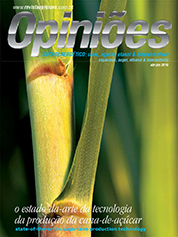José Antonio Bressiani
Breeding Manager of CanaVialis
Op-AA-24
Breeding: technology to supply the world
Sugarcane plantations nowadays occupy more than 8 million hectares in Brazil and generate 500 million tons of sugar each year. Conventional breeding has greatly contributed to the country occupying a leading position in the production of sugar and ethanol. To give an idea, in the past ten years more than 80 varieties of sugarcane were launched in the domestic market.
They may appear alike to laypersons, but they are actually quite dif-ferent, with specific behaviors, placing Brazilian sugarcane breeding programs among the best in the world, if they are not already the best. National research intensified beginning in the 1970’s, with a series of public investments to create Planalsucar (National Sugarcane Improvement Program) and Copersucar (Cooperative of Sugarcane, Sugar and Ethanol Producers of the State of São Paulo).
Nowadays, most mills use varieties developed by these two programs and, to a lesser degree, by IAC – (Agronomical Institute of Campinas), founded in the beginning of the 20th. Century. In recent decades, average agricultural productivity increased 1% per year in tons of sugarcane/ha and 0.3% per year in sugar content, i.e., almost 40% more sugar is produced on the same available space.
Nowadays, one must meet the needs of the new agricultural frontiers, especially the cerrado regions, characterized in general by degraded grazing lands with medium to low fertility soils and lesser quantities of available water. In assessing the current scenario of sugarcane production in an integrated manner, one can understand the huge contribution to breeding in the sugar-based energy industry: higher sugar produc-tivity per area, better adaptation to more restrictive production environments and to mechanized systems that do not resort to burning in harvesting.
In addition, the developed varieties are more resistant to a series of diseases. One should mention that in the last 40 years at least three important diseases struck Brazilian sugarcane plantations. The last, orange-colored rust, appeared at the end of last year and it has not been noticed around here because of our many genetic varieties, whereas in Australia it caused much damage. Of the 100 commercially planted varieties in the country, only three were susceptible to this new disease.
Research will need to be increasingly customized, i.e., better adapted to different types of production environments. The breeding program of CanaVialis, a company belonging to Monsanto and created in 2003, develops specific varieties for each production environment, to better explore the interaction of genotype and the environment, thereby meeting the specific needs of each of its client mills.
Through the Variety Management System, the company not only selects the best genetic material for each demand, but also assesses the performance of new products in comparison with those already being used in sugarcane plantations, set forth in a plan to move forward. Last year, CanaVialis launched its first variety in the market, CV Pégaso, which looks good, has an excellent sprouting capacity and shows high resistance to the main diseases, including orange-color rust.
It stands out in intermediary environments, when compared with the standards, due to high healing and productivity ratings. In future, the use of biotechnology will add complementary characteristics such as tolerance to pests, tolerance to hydric stress, higher sugar concentration for human consumption and the pro-duction of ethanol, as well as the use of the sugar-cane’s sub-product, to the conventional breeding varieties.
In addition to all this, in the next decade we will have a new type of sugarcane, which we ought best call “energy-cane”: a more robust sugarcane with a very high potential for the production of biomass, with twice the capacity of conventional sugarcane, to be used as a source of raw material in the production of energy and also in the production of ethanol via hydrolysis, such as enzyme-based production. The new varieties will further reduce the dependence on oil, providing sustainable development, given that it is a renewable energy source. Brazil will then export this technology thanks to the development of modern processes.




